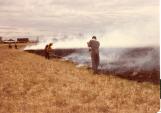1
Dr. Johnson gets the International Biological Program job7 December 1968
2795 Ness Ave, Living Prairie Museum, St. James, Winnipeg, Manitoba, Canada
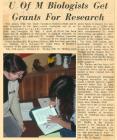
2
...the question of trying to find a job, that was late 60s, not a lot going on anywhere. And so there was one teaching job, in Pennsylvania, actually sorta central Pennsylvania in the States, but I would have had to pay my way down and back. I was the usual starving graduate student, didn't want to go any further in debt, so the post-doc was advertised at the University of Manitoba, it involved biological survey work and I was used to being by myself in the bush kinda thing and doing my own work. So I came out and interviewed with Dr. Jennifer Shay, she was Dr. Jennifer Walker at that point and she and Dr. Nero were in charge, co-chair I think they were of the local International Biological Program survey of Manitoba. So they basically hired me to coordinate the survey work......but they had identified St. James Prairie before I came here, I don't know whether the survey was done in '68 or 69, summer of '69, but I do remember that I certainly heard about it and got out to see it shortly after. Actually I arrived in the province in the fall of 69 and I remember attending several council meetings with Dr. Shay and making presentations for the preserveation of the prairie to city council and to the, well at that point, this was even before Winnipeg had become Unicity, St. James was still its own city. And so we basically convinced the St. James council to set it aside as park and then I think Unicity would have happened in the middle 70s and then the City of Winnipeg, the greater City of Winnipeg just took it over as one of their parks.
3
Conservation of Ecologically Significant Natural Lands2004
Living Prairie Museum, St. James, Winnipeg, Manitoba, Canada
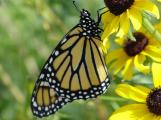
4
And then we also started trying to get preservation for some of these sights, working for the preservation of some of these sites. And some of them were on private land, so we tried to convince the landowners to, this was before the Nature Conservancy was here, there weren't a lot of ways of you know, preserving the land, we tried to get them to deed it to the province, and a lot of the people were very suspicious about the province, didn't trust them to, you know, maintain the land in perpetuity and there really was not a really good way of doing it, but we did try to convince people to not sell it or change its use or whatever. And when it was Crown land then we tried to get things established and sorta from this preservation work then came the Ecological Reserve System and the Ecologically Significant Areas system and the IBP really started that whole push back in the early 70s and then we got an Ecological Resource Act and then we got the system, there still aren't enough, but many of the Crown land IBP sites, now are, are ecological reserves. And there are others, which were found later, that had been added also to that, to that system. Yeah, so that has sorta continued and that has been an interest of mine ever since, and also was of Jennifer's, of Jennifer Shay's also. And we both sat on the Ecological Reserves committee until the Conservatives took over and turfed us off (laughs) and appointed Conservatives. (laughs) Oh yes, that was quite interesting, so that would've been the early 90s, so we sat on it for 15 years or so. And both of us were involved also with environmental protection out at CFB Shilo, because it still got the biggest sorta undisturbed area of dry prairie, sand dune kinda vegetation in the province.5
International Biological Program years1979
Living Prairie Museum, St. James, Winnipeg, Manitoba, Canada
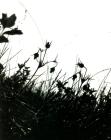
6
The surveys for the prairie would've been done in the summer of 1968 and the summer of 1969. And as I said the St. James prairie was identified and I suspect that it may have been this horticultural society that brought the name forward because what they did was they put out the word to everyone they knew who was a naturalist, or a biologist and advertised in the papers, for people who knew about prairie sites and they put ads in local papers, regional newspapers, to try and get sites. So they had a a list of candidate sites and then they started checking them out. So I think the field work was mostly done in 68 and 69, well I know it was done in 68 and 69, and I visited some of these prairies in 70 and 71.7
First impressions of the Living Prairie Museum site1960
Living Prairie Museum, St. James, Winnipeg, Manitoba, Canada
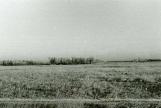
8
(on what first struck Dr. Johnson about the prairie)That it was a pretty diverse area as far as the kinds of plant species in it. Some of the prairie is still pretty weedy where it had been disturbed, but most of the typical native prairie plants were there. And that was of course because it was, limestone was so close to the surface there that they couldn't really dig basements and do anything without spending a lot of money blasting.
9
St. James Horticultural Society and Manitoba Naturalist Society's Involvement1985
Living Prairie Museum, St. James, Winnipeg, Manitoba, Canada
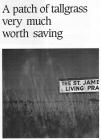 Credits:
Credits:Image courtesy of: Canadian Geographic, August/September 1985
10
But met a lot of interesting people and got involved in the Mantioba Naturalists Society, who also pressed for the preservation of the prairie. At that point they were still the Natural History Society of Manitoba, and they changed their name, I think it must have been…in the middle or late 70s.They make reference to a Horticultural Society that was active in …
That's what Peter De Wet, member I mentioned his name? I think he must have been the chair or the president of the St. James Horticultural Society and I think that society is still in existence but the Province cut funds, they used to give a grant to all the little independent societies, and they cut that grant and they cut the services that the Horticultural Society provided about four or five years ago and I know a lot of those societies have gone under, so I don't know if it's still in existence or not. But St. James was one of the biggest
11
Living Prairie Museum, Conservation Process2004
Living Prairie Museum, St. James, Winnipeg, Manitoba, Canada
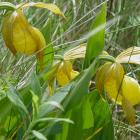
12
Yeah, it had been suggested by the secretary of the St. James Horticultural Society, that's how the prairie got on the candidate list for the IBP, it was suggested by St. James, by the Hort Society right, okay.Do you remember this as being an easy or a difficult process?
It was not..it was time consuming, but not that difficult. I think that the council was quite receptive if I remember correctly. It took you know a year, a reasonable amount of time. There were a lot of people in St. James that wanted, a lot of individuals, besides just the Hort. Society that wanted it preserved. Then they bugged their councillors about it. It wasn't just us from the outside coming in kinda thing. There was a lot of local support for it.
Wonderful.
A lot of people that used to go there and you know, see the crocuses and stuff. And so there was a lot of support. But I don't remember any of the people other than this Mike Gwizda, he was very supportive, the superintendent, yep, of parks. The Rookes and Peter De Wet.
13
Living Prairie Museum's early burns1977
Living Prairie Museum, St. James, Winnipeg, Manitoba, Canada
